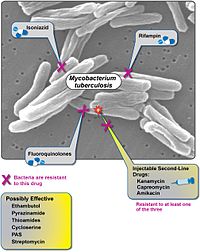
Lead compounds and key residues of ribosomal protein S1 in drug-resistant Mycobacterium tuberculosis.
Sign Up to like & getrecommendations! Published in 2019 at "Bioorganic chemistry"
DOI: 10.1016/j.bioorg.2018.09.024
Abstract: Ribosomal protein S1 (RpsA) has been identified as a novel target of pyrazinoic acid (POA), which is the active form of pyrazinamide (PZA), in vivo. RpsA plays a crucial role in trans-translation, which is widespread… read more here.
Keywords: resistant mycobacterium; drug; drug resistant; tuberculosis ... See more keywords

Conversion of OprO into an OprP-like Channel by Exchanging Key Residues in the Channel Constriction.
Sign Up to like & getrecommendations! Published in 2017 at "Biophysical journal"
DOI: 10.1016/j.bpj.2017.07.004
Abstract: Under phosphate-limiting conditions, the channels OprP and OprO are induced and expressed in the outer membrane of Pseudomonas aeruginosa. Despite their large homology, the phosphate-specific OprP and the diphosphate-specific OprO pores show structural differences in… read more here.
Keywords: conversion opro; opro oprp; amino acids; constriction ... See more keywords

Molecular insight for the role of key residues of calreticulin in its binding activities: A computational study
Sign Up to like & getrecommendations! Published in 2020 at "Computational biology and chemistry"
DOI: 10.1016/j.compbiolchem.2020.107228
Abstract: Calreticulin (CRT) is localized to and has functions in multiple cellular compartments, including the cell surface, the endoplasmic reticulum, and the extracellular matrix. Mutagenesis studies have identified several residues on a concave β-sheet surface of… read more here.
Keywords: role key; surface; study; crt binding ... See more keywords

Uncovering key residues responsible for the thermostability of a thermophilic 1,3(4)-β-d-glucanase from Nong flavor Daqu by rational design.
Sign Up to like & getrecommendations! Published in 2020 at "Enzyme and microbial technology"
DOI: 10.1016/j.enzmictec.2020.109672
Abstract: Fungal 1,3(4)-β-D-glucanases were usually applied in brewing and feedstuff industries, however, the thermostability limits the most their application. The characterized 1,3(4)-β-D-glucanase (NFEg16A) from Chinese Nong-flavor (NF) Daqu showed the highest thermostability among GH16 fungal 1,3(4)-β-D-glucanases,… read more here.
Keywords: nong flavor; thermostability; key residues; s187a ... See more keywords

Enzyme-Mimicking Materials from Designed Self-Assembly of Lysine-Rich Peptides and G-Quadruplex DNA/Hemin DNAzyme: Charge Effect of the Key Residues on the Catalytic Functions.
Sign Up to like & getrecommendations! Published in 2022 at "Biomacromolecules"
DOI: 10.1021/acs.biomac.2c00620
Abstract: In enzymatic active sites, the essential functional groups are spatially arranged as a result of the enzyme three-dimensional folding, which leads to remarkable catalytic properties. We are inspired to self-assemble the polylysine peptides with guanine-rich… read more here.
Keywords: key residues; polylysine dna; polylysine; hemin ... See more keywords

Key Residues in δ Opioid Receptor Allostery Explored by the Elastic Network Model and the Complex Network Model Combined with the Perturbation Method
Sign Up to like & getrecommendations! Published in 2022 at "Journal of chemical information and modeling"
DOI: 10.1021/acs.jcim.2c00513
Abstract: Opioid receptors, a kind of G protein-coupled receptors (GPCRs), mainly mediate an analgesic response via allosterically transducing the signal of endogenous ligand binding in the extracellular domain to couple to effector proteins in the intracellular… read more here.
Keywords: key residues; network; network model; opioid receptor ... See more keywords

Engineering of a Baeyer-Villiger monooxygenase reveals key residues for the asymmetric oxidation of omeprazole sulfide.
Sign Up to like & getrecommendations! Published in 2022 at "Chemical communications"
DOI: 10.1039/d2cc04161h
Abstract: The structure-guided engineering of a BVMO from Rhodococcus aetherivorans (RaBVMO) was performed for its asymmetric sulfoxidation activity toward omeprazole sulfide. Based on the structural model of RaBVMO, key residues that line the substrate entrance tunnel… read more here.
Keywords: key residues; omeprazole sulfide; activity; engineering baeyer ... See more keywords

A computational study to identify the key residues of peroxisome proliferator-activated receptor gamma in the interactions with its antagonists
Sign Up to like & getrecommendations! Published in 2018 at "Journal of Biomolecular Structure and Dynamics"
DOI: 10.1080/07391102.2017.1335618
Abstract: Peroxisome proliferator-activated receptors (PPARs) compose a family of nuclear receptors, PPARα, PPARβ, and PPARγ, which mediate the effects of lipidic ligands at the transcriptional level. Among these, the PPARγ has been known to regulate adipocyte… read more here.
Keywords: peroxisome proliferator; proliferator activated; computational study; mechanics ... See more keywords

Identification of key residues in protein functional movements by using molecular dynamics simulations combined with a perturbation-response scanning method
Sign Up to like & getrecommendations! Published in 2021 at "Chinese Physics B"
DOI: 10.1088/1674-1056/abf12f
Abstract: The realization of protein functional movement is usually accompanied by specific conformational changes, and there exist some key residues that mediate and control the functional motions of proteins in the allosteric process. In the present… read more here.
Keywords: response scanning; perturbation response; protein functional; scanning method ... See more keywords

Key residues of Bacillus thuringiensis Cry2Ab for oligomerization and pore-formation activity
Sign Up to like & getrecommendations! Published in 2021 at "AMB Express"
DOI: 10.1186/s13568-021-01270-0
Abstract: As a pore-forming toxin, activation, oligomerization and pore-formation were both required for the mode of action of Cry toxins. Previous results revealed that the helices α4–α5 of Domain I were involved in the oligomerization of… read more here.
Keywords: cry2ab oligomerization; oligomerization pore; oligomerization; activity ... See more keywords

Identification of Key Residues Essential for the Activation of Plant Immunity by Subtilisin From Bacillus velezensis LJ02
Sign Up to like & getrecommendations! Published in 2022 at "Frontiers in Microbiology"
DOI: 10.3389/fmicb.2022.869596
Abstract: Subtilisin, a serine protease, can trigger defense responses in a wide variety of plants, both locally and systemically, to protect against pathogens. However, key residues of subtilisin to improve resistance to plant diseases remain unknown.… read more here.
Keywords: key residues; subtilisin bacillus; lj02; plant ... See more keywords